The portable milling machine market is estimated to be valued at USD 1291.6 billion in 2025 and is projected to reach USD 2044.5 billion by 2035, registering a compound annual growth rate (CAGR) of 4.7% over the forecast period.
The global portable milling machine market demonstrates steady expansion driven by field maintenance requirements, on-site repair operations, and remote machining applications that necessitate mobile precision equipment capable of performing complex cutting operations without relocating heavy workpieces to fixed machine shops. Industrial maintenance teams implement portable milling systems for in-situ repairs of large machinery, pipeline flanges, and structural components where transportation costs and downtime considerations justify mobile machining investments. The technology's evolution toward computer numerical control integration and automated operation capabilities creates demand for portable systems that maintain precision standards while providing operational flexibility across diverse industrial environments.
Power generation facilities represent a significant application segment where portable milling machines enable turbine component repairs, valve seat machining, and heat exchanger maintenance operations that require precision cutting capabilities at installation locations. Maintenance engineers specify portable systems capable of machining hardened steel components and exotic alloys while maintaining dimensional tolerances necessary for critical rotating equipment repairs. Quality assurance protocols emphasize cutting accuracy verification, surface finish measurement, and geometric tolerance compliance that ensure repaired components meet original equipment manufacturer specifications and operational safety requirements.
Aerospace maintenance operations demonstrate increasing adoption of portable milling equipment for aircraft component repairs, engine overhauls, and structural modifications that must be performed in maintenance hangar environments where component removal proves impractical or cost-prohibitive. Aviation maintenance organizations utilize portable systems for precision machining of aluminum, titanium, and composite materials while maintaining strict quality standards and traceability requirements imposed by aviation safety regulations. Field service applications include emergency repairs and modification work where portable equipment enables rapid response without facility infrastructure dependencies.
Environmental adaptation features enable operation across temperature ranges and humidity conditions typical of industrial field environments where climate control proves unavailable or inadequate. Contamination protection systems prevent cutting fluid ingress and debris accumulation that could compromise machine accuracy and reliability during extended field deployments. Corrosion-resistant materials and protective coatings ensure equipment longevity in harsh chemical environments and marine applications where conventional machine tools would suffer accelerated deterioration.
Training and certification programs ensure operator competency and safety compliance as portable milling operations require specialized knowledge regarding setup procedures, safety protocols, and quality verification methods that differ from conventional machine shop practices where fixed equipment and controlled environments provide inherent stability and support systems.
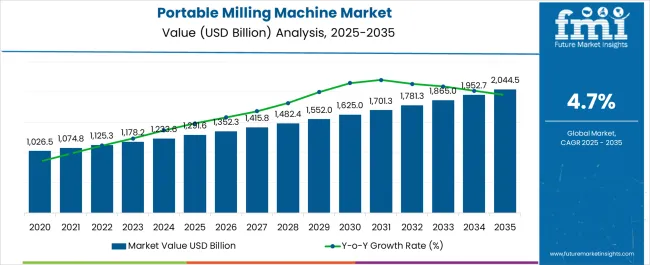
| Metric | Value |
|---|---|
| Portable Milling Machine Market Estimated Value in (2025 E) | USD 1291.6 billion |
| Portable Milling Machine Market Forecast Value in (2035 F) | USD 2044.5 billion |
| Forecast CAGR (2025 to 2035) | 4.7% |
The portable milling machine market is experiencing notable growth due to increasing demand for compact, efficient, and user friendly equipment that supports both commercial and individual needs. Rising adoption of portable solutions has been influenced by the growing preference for convenience and space saving designs across various industries.
Technological advancements in lightweight materials, energy efficiency, and precision engineering have further strengthened the value proposition of portable milling machines. The food and beverage sector, in particular, has been a significant driver, as demand for freshly ground products continues to rise.
Expanding applications in small scale commercial setups and the rising culture of on demand food and beverage services are fueling adoption. The overall outlook remains positive as manufacturers focus on enhancing functionality, durability, and customization to meet evolving consumer and business requirements.
The market is segmented by Type and Application and region. By Type, the market is divided into Portable Coffee Milling Machine, Portable Flour Milling Machine, and Others. In terms of Application, the market is classified into Restaurants, Hotels, Cafes, and Household Use. Regionally, the market is classified into North America, Latin America, Western Europe, Eastern Europe, Balkan & Baltic Countries, Russia & Belarus, Central Asia, East Asia, South Asia & Pacific, and the Middle East & Africa.
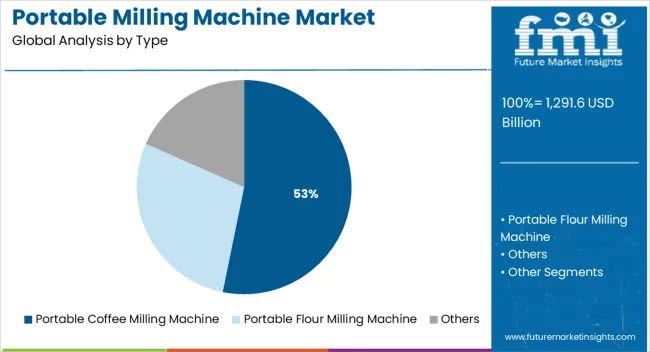
The portable coffee milling machine type segment is expected to contribute 53.20% of total revenue by 2025 within the type category, making it the leading segment. Growth of this segment is being driven by rising consumer preference for freshly ground coffee in both commercial and household environments.
The convenience offered by compact portable machines coupled with improved precision grinding technologies has enhanced their acceptance. Increased penetration of café culture and specialty coffee consumption has further supported segment growth.
Manufacturers are also focusing on innovations in durability and design which has reinforced confidence in the adoption of these machines across global markets.
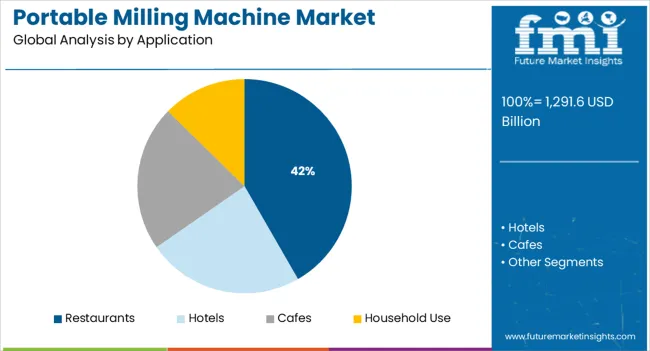
The restaurants application segment is projected to account for 41.70% of total market revenue by 2025, positioning it as the dominant application area. This is attributed to the consistent demand for freshly ground ingredients that enhance flavor and quality in food service operations.
The ability of portable milling machines to provide on demand grinding solutions while saving space in commercial kitchens has strengthened their use in restaurants. Additionally, emphasis on improving customer dining experience and differentiation through premium offerings has accelerated adoption.
As restaurants continue to focus on efficiency, consistency, and quality enhancement, portable milling machines are expected to maintain their leadership within the application segment.
During the historical period (2020 to 2025), the global market for portable milling machines exhibited a moderate CAGR of 4.2%. The market expanded from USD 1026.5 Million in 2020 to USD 1,125.3 Million in 2025, says a new report by Future Market Insights.
The global market for portable milling machines is expected to witness significant growth in the next ten years. Key drivers of this market are increasing demand for portable milling machines from the HoReCa industry and growing demand for refurbished milling machines in underdeveloped nations.
Growing trend for using refurbished machinery is also acting as a driver for growth in this market. Refurbished portable milling machines are available at a fraction of cost of new machines and offer similar performance rates.
Numerous factors have been identified to stir the soup in the market for portable milling machines. Apart from the burgeoning aspects triumphing in the industry, lead analysts at Future Market Insights have scrutinized the future challenges, restraints, growth opportunities, and driving factors that can influence the portable milling machine market.
The drivers, restraints, opportunities, and threats (DROTs) identified are as follows:
DRIVERS
RESTRAINTS
OPPORTUNITIES
THREATS
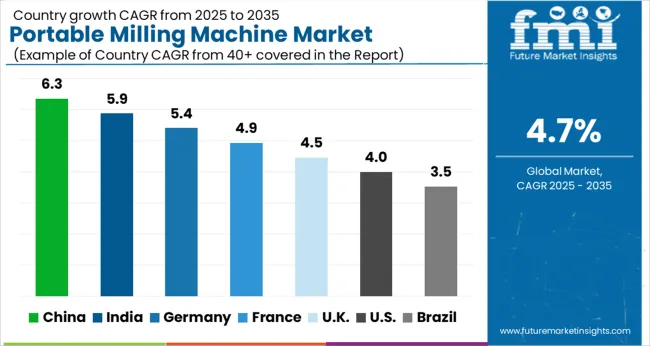
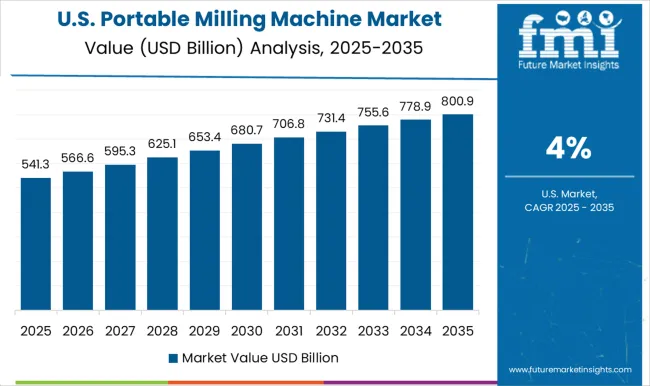
HoReCa Sector in the United States to Look for Unique Portable CNC Milling Machines
Growth in the portable milling machine industry is expected to continue to expand in the United States at a healthy rate in the next ten years. This growth will be mainly driven by the continuous expansion of the hotel/restaurant/catering (HoReCa) industry, as well as increasing popularity of these machines for residential use. The portable milling machine market is set to receive nearly 34.2% of its total income from the United States
Increasing Demand for Ready-to-eat Food Items to Spur Sales of Portable Magnetic Milling Machines in the United Kingdom
The portable milling machine market in the United Kingdom is developing rapidly. With increasing demand for ready-to-eat food items, milling machines are becoming an essential part of the HoReCa industry across the nation. Portable milling machines offer a versatile solution for a wide variety of applications, and can be used in both horizontal and vertical orientations. The United Kingdom is projected to exhibit a CAGR of 6.4% over the assessment period, while Germany is anticipated to generate a share of around 22.8% across Europe.
Growing Presence of Fast Food Chains in China, India, and Japan to Fuel Demand for Portable Magnetic Milling Machines
The market for portable milling machines is expanding rapidly in Asia Pacific. Significant drivers of this growth are expansion of the HoReCa industry and high demand for mass production of numerous goods such as fast food.
Portable milling machines offer high precision and accuracy, and are easy to operate. Asia Pacific region is expected to witness the impressive growth rate due to the presence of numerous HoReCa chains in countries such as China, India, and Japan.
India and China are the market leaders in Asia Pacific, and their most recent CAGRs in the portable milling machine industry are 6.4% and 6.4%, respectively. Japan, on the other hand, is set to contribute to around 3.8% of the market's overall share.
Restaurants, Hotels, and Cafes to Extensively Utilize Portable Steel Milling Machines
The food and beverage industry is one of the most competitive industries in the world. In order to stay ahead of the competition, leading companies are always looking for new and innovative ways to increase efficiency and productivity. One of the latest trends in this industry is the use of portable milling machines.
Portable milling machines are compact and lightweight, making them ideal for use in restaurants, hotels, and cafes. They can be used to quickly and easily mill ingredients, thereby saving time and money. Additionally, they can be used to create customized products, providing key companies with a competitive edge.
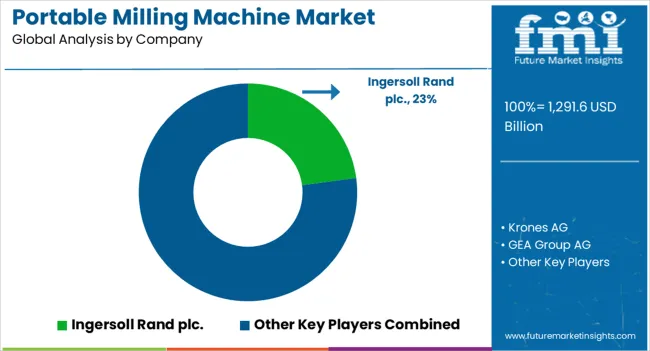
The portable milling machine market includes global industrial equipment manufacturers and specialized engineering firms providing compact, high-precision milling solutions for on-site machining and maintenance applications. Ingersoll Rand plc leads the market with its range of portable and pneumatic milling machines designed for heavy-duty industrial maintenance, construction, and fabrication tasks requiring mobility and reliability.
Krones AG, GEA Group AG, and Alfa Laval AB contribute indirectly through their precision engineering expertise and modular equipment systems used in processing industries, where portable milling units support maintenance and component repair operations. Tetra Pak International S.A. integrates portable milling technology into its packaging and processing maintenance systems to enhance production efficiency and minimize downtime in food and beverage facilities.
Romaco Group and Nichrome Packaging Solutions utilize portable milling machinery for precision component manufacturing within their packaging equipment lines, focusing on compact and easily deployable solutions. Nalbach Engineering Company, All-Fill Inc., and Paxiom Group employ portable milling machines for prototype development, equipment repair, and modification in filling and automation systems.
| Attribute | Details |
|---|---|
| Estimated Market Size (2025) | USD 1291.6 billion |
| Projected Market Valuation (2035) | USD 2044.5 billion |
| Value-based CAGR (2025 to 2035) | 4.7% |
| Forecast Period | 2025 to 2035 |
| Historical Data Available for | 2020 to 2025 |
| Market Analysis | Value (USD Million) |
| Key Regions Covered | North America; Europe; Asia Pacific; Latin America; Middle East & Africa |
| Key Countries Covered | United States, Canada, Mexico, Germany, United Kingdom, France, Russia, Brazil, Argentina, Japan, Australia, China, India, Indonesia, South Korea |
| Key Segments Covered | Type, Application, Region |
| Key Companies Profiled |
Ingersoll Rand plc, Krones AG, GEA Group AG, Alfa Laval AB, Tetra Pak International S.A., Romaco Group, Nichrome Packaging Solutions, Nalbach Engineering Company, All-Fill Inc., and Paxiom Group. |
| Report Coverage | Strategic Growth Initiatives, DROT Analysis, Market Forecast, Company Share Analysis, Market Dynamics and Challenges, and Competitive Landscape |
The global portable milling machine market is estimated to be valued at USD 1,291.6 billion in 2025.
The market size for the portable milling machine market is projected to reach USD 2,044.5 billion by 2035.
The portable milling machine market is expected to grow at a 4.7% CAGR between 2025 and 2035.
The key product types in portable milling machine market are portable coffee milling machine, portable flour milling machine and others.
In terms of application, restaurants segment to command 41.7% share in the portable milling machine market in 2025.
x






Our Research Products

The "Full Research Suite" delivers actionable market intel, deep dives on markets or technologies, so clients act faster, cut risk, and unlock growth.

The Leaderboard benchmarks and ranks top vendors, classifying them as Established Leaders, Leading Challengers, or Disruptors & Challengers.

Locates where complements amplify value and substitutes erode it, forecasting net impact by horizon

We deliver granular, decision-grade intel: market sizing, 5-year forecasts, pricing, adoption, usage, revenue, and operational KPIs—plus competitor tracking, regulation, and value chains—across 60 countries broadly.

Spot the shifts before they hit your P&L. We track inflection points, adoption curves, pricing moves, and ecosystem plays to show where demand is heading, why it is changing, and what to do next across high-growth markets and disruptive tech

Real-time reads of user behavior. We track shifting priorities, perceptions of today’s and next-gen services, and provider experience, then pace how fast tech moves from trial to adoption, blending buyer, consumer, and channel inputs with social signals (#WhySwitch, #UX).

Partner with our analyst team to build a custom report designed around your business priorities. From analysing market trends to assessing competitors or crafting bespoke datasets, we tailor insights to your needs.
Supplier Intelligence
Discovery & Profiling
Capacity & Footprint
Performance & Risk
Compliance & Governance
Commercial Readiness
Who Supplies Whom
Scorecards & Shortlists
Playbooks & Docs
Category Intelligence
Definition & Scope
Demand & Use Cases
Cost Drivers
Market Structure
Supply Chain Map
Trade & Policy
Operating Norms
Deliverables
Buyer Intelligence
Account Basics
Spend & Scope
Procurement Model
Vendor Requirements
Terms & Policies
Entry Strategy
Pain Points & Triggers
Outputs
Pricing Analysis
Benchmarks
Trends
Should-Cost
Indexation
Landed Cost
Commercial Terms
Deliverables
Brand Analysis
Positioning & Value Prop
Share & Presence
Customer Evidence
Go-to-Market
Digital & Reputation
Compliance & Trust
KPIs & Gaps
Outputs
Full Research Suite comprises of:
Market outlook & trends analysis
Interviews & case studies
Strategic recommendations
Vendor profiles & capabilities analysis
5-year forecasts
8 regions and 60+ country-level data splits
Market segment data splits
12 months of continuous data updates
DELIVERED AS:
PDF EXCEL ONLINE
Milling Machine Market Growth – Trends & Forecast 2025 to 2035
Portable Boring Machines Market Size and Share Forecast Outlook 2025 to 2035
End Milling Machine Market Report - Demand, Growth & Industry Outlook 2025 to 2035
Portable Sealing Machine Market Size and Share Forecast Outlook 2025 to 2035
Road Milling Machine Market Analysis and Opportunity Assessment in India Size and Share Forecast Outlook 2025 to 2035
Rice Milling Machine Market Size and Share Forecast Outlook 2025 to 2035
Tree Milling Machine Market Size and Share Forecast Outlook 2025 to 2035
Corn Milling Machine Market Size and Share Forecast Outlook 2025 to 2035
Maize Milling Machine Market Size and Share Forecast Outlook 2025 to 2035
Wheat Milling Machine Market Size and Share Forecast Outlook 2025 to 2035
Thread Milling Machine Market Size and Share Forecast Outlook 2025 to 2035
Universal Milling Machine Market Size and Share Forecast Outlook 2025 to 2035
Horizontal Milling Machine Market Size and Share Forecast Outlook 2025 to 2035
Desktop CNC Milling Machines Market Size and Share Forecast Outlook 2025 to 2035
Tabletop CNC Milling Machines Market Analysis - Size, Share, and Forecast Outlook 2025 to 2035
Industrial Food Milling Machine Market Size and Share Forecast Outlook 2025 to 2035
Portable Audiometer Calibration System Market Size and Share Forecast Outlook 2025 to 2035
Portable Crushers Market Size and Share Forecast Outlook 2025 to 2035
Machine Glazed Paper Market Size and Share Forecast Outlook 2025 to 2035
Machine Glazed Kraft Paper Market Forecast and Outlook 2025 to 2035

Thank you!
You will receive an email from our Business Development Manager. Please be sure to check your SPAM/JUNK folder too.
Chat With
MaRIA